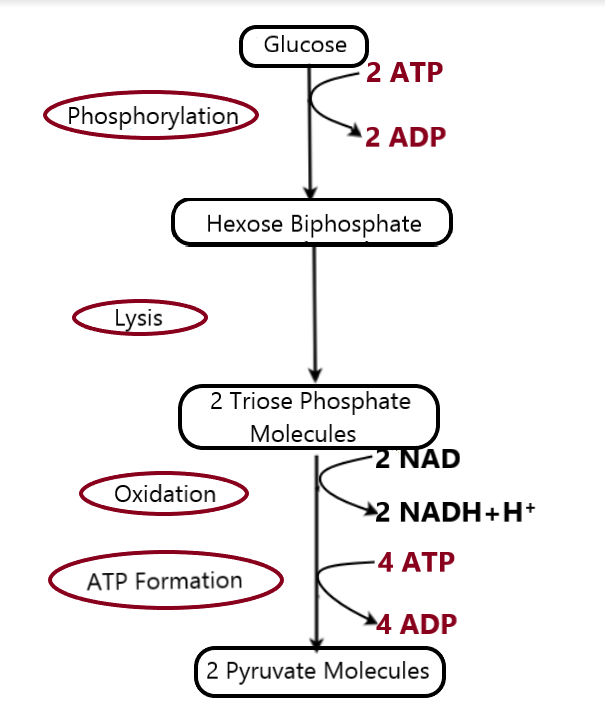
Glycolysis occurs in the ____________ of the cell.
Answer
572.1k+ views
Hint: Fluid within the cell which contains various organelles and enclosed by the cell membrane.
Complete answer:
Glycolysis is a process by which the breakdown of glucose takes place to produce energy for cellular metabolism. It occurs in the cytosol of the cell. It produces two molecules of pyruvate, $C{ H }_{ 3 }{ C }{ O }{ C }{ O }{ O }{ - }$ (pyruvic acid)and a hydrogen ion H+. The free energy released during this process is employed to make the high energy molecule ATP and NADH. It is an oxygen-independent metabolic pathway which is a sequence of ten enzyme-catalyzed reactions. The pathway can be separated into two phases:-
1.Phase one - the preparatory or investment phase wherein ATP is consumed.
2.Phase two - the pay off phase wherein ATP is produced.
Glycolysis occurs in the cytosol of the cell cytoplasm because the glucose and other related enzymes required for the glycolytic pathway can be easily found there in high concentration. The cytoplasm may be a thick solution that fills each cell and is enclosed by the cell wall. It is mainly composed of water, salts, and protein. In eukaryotic cells, the cytoplasm includes all of the fabric inside the cell and out of the doors of the nucleus. It occurs in both prokaryotic and eukaryotic cells.
Additional Information: -Phase one of glycolysis is also known as the energy-requiring steps. This pathway traps the glucose molecule in the cell and uses energy to modify it so that the six-carbon sugar molecule can be split evenly into the two three-carbon molecules.
-Phase two of glycolysis is also known as energy-releasing steps. Extracts energy from the molecules and stores it within the sort of ATP and NADH, the reduced sort of NAD.
Note:
-Pyruvate is a molecule of three-carbon sugar $C{ H }_{ 3 }{ C }{ O }{ C }{ O }{ O }{ - }$
-ATP-Adenosine triphosphate.
-NADH-Nicotinamide adenine dinucleotide.
-Mature mammalian red blood cells are not capable of aerobic respiration.

Complete answer:
Glycolysis is a process by which the breakdown of glucose takes place to produce energy for cellular metabolism. It occurs in the cytosol of the cell. It produces two molecules of pyruvate, $C{ H }_{ 3 }{ C }{ O }{ C }{ O }{ O }{ - }$ (pyruvic acid)and a hydrogen ion H+. The free energy released during this process is employed to make the high energy molecule ATP and NADH. It is an oxygen-independent metabolic pathway which is a sequence of ten enzyme-catalyzed reactions. The pathway can be separated into two phases:-
1.Phase one - the preparatory or investment phase wherein ATP is consumed.
2.Phase two - the pay off phase wherein ATP is produced.
Glycolysis occurs in the cytosol of the cell cytoplasm because the glucose and other related enzymes required for the glycolytic pathway can be easily found there in high concentration. The cytoplasm may be a thick solution that fills each cell and is enclosed by the cell wall. It is mainly composed of water, salts, and protein. In eukaryotic cells, the cytoplasm includes all of the fabric inside the cell and out of the doors of the nucleus. It occurs in both prokaryotic and eukaryotic cells.
Additional Information: -Phase one of glycolysis is also known as the energy-requiring steps. This pathway traps the glucose molecule in the cell and uses energy to modify it so that the six-carbon sugar molecule can be split evenly into the two three-carbon molecules.
-Phase two of glycolysis is also known as energy-releasing steps. Extracts energy from the molecules and stores it within the sort of ATP and NADH, the reduced sort of NAD.
Note:
-Pyruvate is a molecule of three-carbon sugar $C{ H }_{ 3 }{ C }{ O }{ C }{ O }{ O }{ - }$
-ATP-Adenosine triphosphate.
-NADH-Nicotinamide adenine dinucleotide.
-Mature mammalian red blood cells are not capable of aerobic respiration.

Fig.- Glycolysis
Recently Updated Pages
Master Class 12 Business Studies: Engaging Questions & Answers for Success

Master Class 12 Economics: Engaging Questions & Answers for Success

Master Class 12 English: Engaging Questions & Answers for Success

Master Class 12 Maths: Engaging Questions & Answers for Success

Master Class 12 Social Science: Engaging Questions & Answers for Success

Master Class 12 Chemistry: Engaging Questions & Answers for Success

Trending doubts
What is meant by exothermic and endothermic reactions class 11 chemistry CBSE

Which animal has three hearts class 11 biology CBSE

10 examples of friction in our daily life

One Metric ton is equal to kg A 10000 B 1000 C 100 class 11 physics CBSE

1 Quintal is equal to a 110 kg b 10 kg c 100kg d 1000 class 11 physics CBSE

Difference Between Prokaryotic Cells and Eukaryotic Cells




